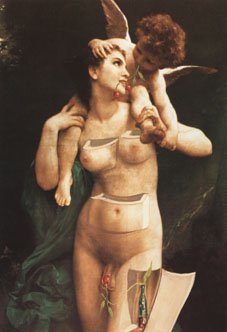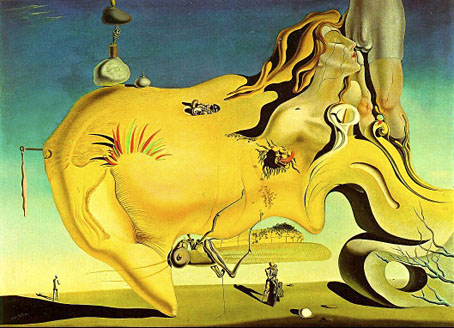The paranoiac-critical gaze: Dirty Dalí.
I finally managed to see this fascinating documentary this week. Since my TV broke down some time ago I refused to waste money buying another, partly for the reason that films such as this are increasingly rare and most of them have been shunted to minority channel BBC 4 which I can’t receive. Thanks to BitTorrent you can still find the worthwhile stuff, of course, but this often requires patience.

The Wines of Gala and of God (1977).
Dirty Dalí: A Private View was a reminiscence by art critic Brian Sewell about his encounters with Dalí and wife Gala at their home in Port Lligat in the late 60s and early 70s. What’s interesting about it is the first-hand light it throws on Dalí’s complicated sexuality, a subject which has been the source of speculation in biographies (notably Ian Gibson’s The Shameful Life of Salvador Dalí) but which is confused by the artist’s simultaneous revealing of his obsessions in his art and the veiling of his interests in public statements, not least the frequent declarations of impotence. Sewell confirms that Dalí was interested in both men and women although purely as a voyeur, and relates how his first encounter with the artist led to his having to lie naked in the armpit of a giant Christ sculpture in Dalí’s garden, masturbating while Dalí took photographs. Sewell also examines Dalí’s affair with Federico García Lorca, the closest the artist came to a gay romance, and his subsequent relationship with Gala, which became one where the pair used the artist’s celebrity to attract delectable people of both sexes, like a pair of art world super-swingers. According to Sewell, Dalí’s physical ideal was the hermaphrodite which would possibly explain his attraction to (alleged) transsexual Amanda Lear during this time.

The Great Masturbator (1929).
As a piece of television the film struggles to fill out its running time by resorting to animating photographs, a persistent hazard for documentaries that lack the relevant raw material. All the footage of Dalí is lifted from previous documentary films including a large chunk of Russell Harty’s Aquarius interview, Hello Dali! (that camp double-entendre now seems very apt), from 1973. The overall effect of Sewell’s narrative is to add to Dalí’s already considerable feet of clay but that’s the inevitable outcome of nearly any biography; real lives are always messy. Sewell nonetheless ends by reaffirming Dalí’s principal importance as one of the great painters of the 20th century and, in an interesting side note, declares him to be the last great painter of a religious work with his Christ of St John of the Cross. A great religious artist and also one who produced hundreds of pornographic drawings, some of which are seen in the film. In art, as in the life, the contradictions are everywhere.
• Dirty Dalí at Grey Lodge
• Homage to Catalonia: Robert Hughes on Dalí
Previously on { feuilleton }
• Impressions de la Haute Mongolie revisited
• Dalí and Film
• Ballard on Dalí
• Fantastic art from Pan Books
• Penguin Surrealism
• The Surrealist Revolution
• The persistence of DNA
• Salvador Dalí’s apocalyptic happening
• The music of Igor Wakhévitch
• Dalí Atomicus
• Las Pozas and Edward James
• Impressions de la Haute Mongolie


Hi John
I’d have thought a much more reliable and insightful witness to the Dali’s complex relationship would be the great John Richardson, PIcasso biographer and one-time New York dealer for the pair. His incredibly funny Dali’s Gala (in the collection Sacred Monsters, Sacred Masters) draws on Gibson’s book but deserves a documentary – hell, a feature film starring Johnny Depp and Helena Bonham-Carter – in it’s own right, such are the goings-on. “To know her was to loathe her”, he writes of the wife of “the seedy old conjuror”.
Oh, I didn’t know Richardson had written about Dalí (although it makes sense), thanks for the tip. However, I tend to be wary of any argument that paints Gala as some kind of villainous hag. Whatever her faults, she remains central to his work as well as his life, as much as Picasso’s women are central to his.
That’s a good suggestion about Depp. Dalí was pretty handsome and dashing in his New York years, he could probably pull it off.
I know what you mean – behind every bad man is an even more rotten woman-type misogyny – but Richardson’s account, though waspish, is utterly believable and he is equally horrible about the pair of them.
Think I should copyright the idea and get the call in to T. Burton pronto then?
Maybe you should. I would have been sceptical about such a proposal at one time but Burton managed to get more serious with Ed Wood and Depp’s acting talent is certainly up to the job.
For Dali fans I have a few Dali documentaries to trade.
Dirty Dali [as bove] 2007
St John of the Cross – doc about this controversial painting. 2004
Aquarius – documentary 1973
Dave
http://dvd247.tripod.comart_list.html